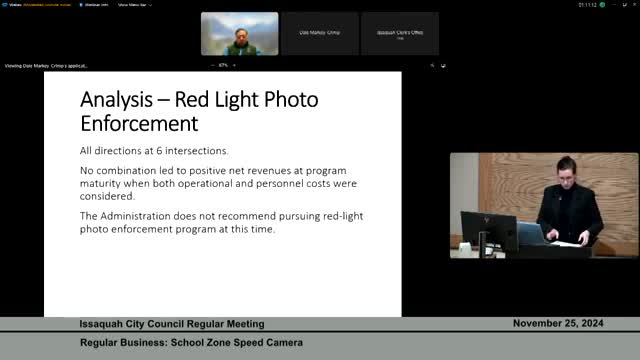City plans new traffic cameras to enhance school zone safety
November 27, 2024 | Issaquah, King County, Washington
This article was created by AI summarizing key points discussed. AI makes mistakes, so for full details and context, please refer to the video of the full meeting. Please report any errors so we can fix them. Report an error »

In a recent government meeting, officials discussed the findings of a red light camera study and the potential expansion of school zone safety measures in Issaquah. The initial study, conducted in June, assessed traffic violations at various intersections and revealed that while dangerous driving behaviors persist, the majority do not involve running red lights, which are the primary focus of photo enforcement cameras. The Chief of Police presented detailed information on how these cameras operate, noting that most intersections studied recorded fewer than one violation per day, raising concerns about the financial viability of installing and maintaining such systems.
In response to ongoing safety concerns, particularly in school zones, a second study was conducted in September, capturing data during school hours. This analysis indicated a staggering number of violations—between 1,100 and 1,600 per day—highlighting significant speeding issues despite existing warning systems. The city is now evaluating the financial implications of expanding its automated traffic camera program, considering both potential revenues and operational costs.
The administration proposed adding a second school zone camera at Issaquah Valley Elementary, which would not trigger new revenue restrictions under recent state legislation. This proposal aims to address the high incidence of speeding in school zones while ensuring that any excess revenue generated would be reinvested into local transportation projects, such as sidewalk improvements.
The meeting also touched on equity considerations, as the placement of cameras could disproportionately affect certain demographics. An equity impact assessment revealed that while residents in the targeted areas might face more interactions with the cameras, they would also benefit from improved safety as driver behavior changes.
The administration is moving forward with plans to communicate with the community and collaborate with the school district, aiming to install the new cameras by early next year. The council committee has expressed support for the proposed measures, although discussions continue regarding the potential for additional camera locations in the future.
In response to ongoing safety concerns, particularly in school zones, a second study was conducted in September, capturing data during school hours. This analysis indicated a staggering number of violations—between 1,100 and 1,600 per day—highlighting significant speeding issues despite existing warning systems. The city is now evaluating the financial implications of expanding its automated traffic camera program, considering both potential revenues and operational costs.
The administration proposed adding a second school zone camera at Issaquah Valley Elementary, which would not trigger new revenue restrictions under recent state legislation. This proposal aims to address the high incidence of speeding in school zones while ensuring that any excess revenue generated would be reinvested into local transportation projects, such as sidewalk improvements.
The meeting also touched on equity considerations, as the placement of cameras could disproportionately affect certain demographics. An equity impact assessment revealed that while residents in the targeted areas might face more interactions with the cameras, they would also benefit from improved safety as driver behavior changes.
The administration is moving forward with plans to communicate with the community and collaborate with the school district, aiming to install the new cameras by early next year. The council committee has expressed support for the proposed measures, although discussions continue regarding the potential for additional camera locations in the future.
View full meeting
This article is based on a recent meeting—watch the full video and explore the complete transcript for deeper insights into the discussion.
View full meeting
